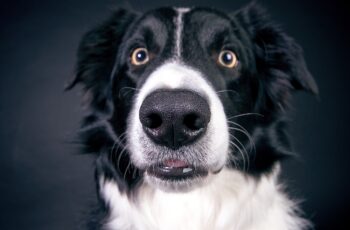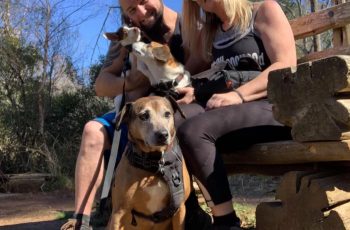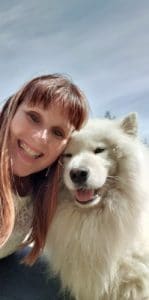 According to Wikipedia, the Samoyed is a breed of large herding dogs with thick, white, double-layer coats. They are related to the Laika, a spitz-type dog. It takes its name from the Samoyedic peoples of Siberia. These nomadic reindeer herders bred the fluffy white dogs to help with herding.
According to Wikipedia, the Samoyed is a breed of large herding dogs with thick, white, double-layer coats. They are related to the Laika, a spitz-type dog. It takes its name from the Samoyedic peoples of Siberia. These nomadic reindeer herders bred the fluffy white dogs to help with herding.
They have a lively, stubborn, sociable, alert, friendly, playful temperaments.
They live up to Life 12 – 13 years and originally from Siberia, Russia.
Carolyn and David’s Dog Lars
This is Lars, who is 5 1/2 years old, purebred Samoyed from New Zealand. His owner, Carolyn Kaye, shares, “We got him because we had lost our previous Samoyed, Jasper, three years old, who died from viral peritonitis from a third operation because he had eaten part of a tennis ball that got stuck in him.
After he died, which was heartbreaking, we contacted our breeder, who happened to be having a litter born in the next couple of weeks, and they were happy for us to have a puppy of it worked out.
 Another male pup was born who we ended up getting, Lars. His mother, was sister to Jasper’s mother, and his father was brother to Jasper’s father, so Lars was a direct first cousin to Jasper, on both sides. We had prayed about the dog we were getting, and it seemed that God was ordering events.
Another male pup was born who we ended up getting, Lars. His mother, was sister to Jasper’s mother, and his father was brother to Jasper’s father, so Lars was a direct first cousin to Jasper, on both sides. We had prayed about the dog we were getting, and it seemed that God was ordering events.
When Lars came, our three sons were teenagers. We sat around the lounge coffee table, and I said, “Let’s find a name that we all agree on,” and a lot of names were bantered about. In the end, I got everyone to write a list of their five top names in order of preference, and from there, the highest-ranking overall name was Lars. (Probably after a children’s book series that the boys loved, called Lars, the Polar Bear).
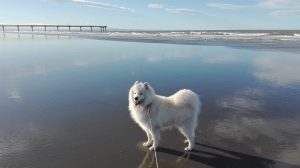 According to Carolyn, they made sure Lars wasn’t left with any tennis balls and made sure their section and house were clear of anything he could eat that could get stuck in him. But despite their best efforts, he did get two blockages and has had two operations. She assumes from rubbish he picked up at parks. Now, when they take him on walks and runs about, they have to put a muzzle on him, and he is never off-leash, so he can’t eat anything he shouldn’t. She says that it may seem harsh, but the vet said, another blockage could kill him. So Lars’s safety is a priority.
According to Carolyn, they made sure Lars wasn’t left with any tennis balls and made sure their section and house were clear of anything he could eat that could get stuck in him. But despite their best efforts, he did get two blockages and has had two operations. She assumes from rubbish he picked up at parks. Now, when they take him on walks and runs about, they have to put a muzzle on him, and he is never off-leash, so he can’t eat anything he shouldn’t. She says that it may seem harsh, but the vet said, another blockage could kill him. So Lars’s safety is a priority.
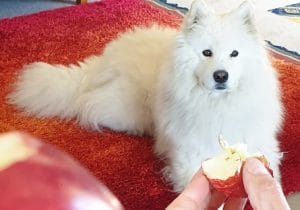 Carolyn continues and says, “He gets lots of love and affection from all of us. My boys have now left home but are close by. Lars loves his runs and walks, is more of a tourist dog than an exercise dog. He loves to look around, loves new places, and smells. He loves games of toy pulling, not so much a fetch dog. And of course, loves his treats of banana, apple, bits of ginger nut biscuit, and store-bought treats.
Carolyn continues and says, “He gets lots of love and affection from all of us. My boys have now left home but are close by. Lars loves his runs and walks, is more of a tourist dog than an exercise dog. He loves to look around, loves new places, and smells. He loves games of toy pulling, not so much a fetch dog. And of course, loves his treats of banana, apple, bits of ginger nut biscuit, and store-bought treats.
Wherever he hears someone in the kitchen, he’s there, waiting for carrot ends when I’m preparing tea, or if someone is eating an apple, he comes knowing we always give him the core.
He always wags his bushy tail and stands to greet us when we come home. He has a happy face with his Samoyed smile, does a wolf-like howl when excited, and sometimes leaps around as he does on sand and snow. He’s a lot of fun, and we love him heaps.”
Samoyed’s Distinguishing Features
As you can see from Lars’ pictures, Samoyed ears are thick and covered with fur, triangular in shape, and erect. They are almost always white but can often have a light to dark brown tint (known as “biscuit”), usually around the ears’ tips.
The Samoyed tail is one of the breed’s distinguishing features. Their tail is carried curled over the back. In cold weather, Samoyeds may sleep with their tails over their noses to provide additional warmth. Almost all Samoyeds will allow their tails to fall when they are relaxed and at ease, as when being stroked or while eating, but will return their tails to a curl when more alert.
Source
https://en.wikipedia.org/wiki/Samoyed_(dog)

